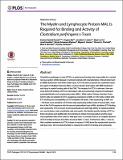Por favor, use este identificador para citar o enlazar a este item:
http://hdl.handle.net/10261/140596COMPARTIR / EXPORTAR:
 SHARE SHARE
 CORE
BASE CORE
BASE
|
|
| Visualizar otros formatos: MARC | Dublin Core | RDF | ORE | MODS | METS | DIDL | DATACITE | |

| Título: | The Myelin and Lymphocyte Protein MAL Is Required for Binding and Activity of Clostridium perfringens ε-Toxin |
Autor: | Rumah, Kareem Rashid; Ma, Yinghua; Linden, Jennifer R.; Oo, Myat Lin; Anrather, Josef; Schaeren-Wiemers, Nicole; Alonso, Miguel A. CSIC ORCID; Fischetti, Vicent A.; McClain, Mark S.; Vartanian, Timothy | Fecha de publicación: | 20-may-2015 | Editor: | Public Library of Science | Citación: | PLoS Pathogens 11 (2015) | Resumen: | © 2015 Rumah et al. Clostridium perfringens ε-toxin (ETX) is a potent pore-forming toxin responsible for a central nervous system (CNS) disease in ruminant animals with characteristics of blood-brain barrier (BBB) dysfunction and white matter injury. ETX has been proposed as a potential causative agent for Multiple Sclerosis (MS), a human disease that begins with BBB breakdown and injury to myelin forming cells of the CNS. The receptor for ETX is unknown. Here we show that both binding of ETX to mammalian cells and cytotoxicity requires the tetraspan proteolipid Myelin and Lymphocyte protein (MAL). While native Chinese Hamster Ovary (CHO) cells are resistant to ETX, exogenous expression of MAL in CHO cells confers both ETX binding and susceptibility to ETX-mediated cell death. Cells expressing rat MAL are ~100 times more sensitive to ETX than cells expressing similar levels of human MAL. Insertion of the FLAG sequence into the second extracellular loop of MAL abolishes ETX binding and cytotoxicity. ETX is known to bind specifically and with high affinity to intestinal epithelium, renal tubules, brain endothelial cells and myelin. We identify specific binding of ETX to these structures and additionally show binding to retinal microvasculature and the squamous epithelial cells of the sclera in wild-type mice. In contrast, there is a complete absence of ETX binding to tissues from MAL knockout (MAL-/-) mice. Furthermore, MAL-/- mice exhibit complete resistance to ETX at doses in excess of 1000 times the symptomatic dose for wild-type mice. We conclude that MAL is required for both ETX binding and cytotoxicity. | URI: | http://hdl.handle.net/10261/140596 | DOI: | 10.1371/journal.ppat.1004896 | Identificadores: | doi: 10.1371/journal.ppat.1004896 issn: 1553-7374 |
| Aparece en las colecciones: | (CBM) Artículos |
Ficheros en este ítem:
| Fichero | Descripción | Tamaño | Formato | |
|---|---|---|---|---|
| Alonso MA The Myelin.pdf | 14,37 MB | Adobe PDF |  Visualizar/Abrir |
CORE Recommender
PubMed Central
Citations
46
checked on 21-abr-2024
SCOPUSTM
Citations
61
checked on 24-abr-2024
WEB OF SCIENCETM
Citations
61
checked on 23-feb-2024
Page view(s)
148
checked on 21-abr-2024
Download(s)
180
checked on 21-abr-2024

